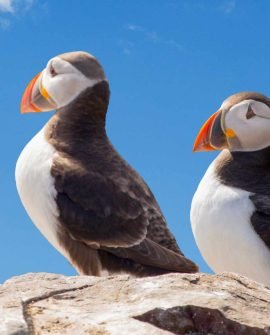Is January the right time to visit Iceland ?
Is January the right time to visit Iceland? For those who are enchanted by winter landscapes and unique seasonal activities, January offers a magical experience. This month provides an excellent opportunity to witness the mesmerizing Northern Lights, thanks to the long, dark nights. The winter season transforms the scenery into a picturesque wonderland, perfect for ice caving, glacier hiking, and soaking in hot springs surrounded by snow.
However, travelers should be prepared for cold temperatures, limited daylight, and potentially challenging travel conditions due to snow and ice. It’s essential to dress warmly, plan activities during the limited daylight hours, and remain flexible with travel plans.
Despite these challenges, the reduced tourist crowds in January mean you can enjoy Iceland’s natural beauty and cultural attractions in a more serene and intimate setting. For winter enthusiasts and those seeking a unique adventure, January can indeed be the right time to visit Iceland.
The weather in Iceland during January?
In January, Iceland experiences some of its coldest and darkest weather of the year. Here is an overview of the typical weather conditions you can expect during this month:
- Temperature:
- Average High: Around 2°C (36°F)
- Average Low: Around -1°C (30°F)
- Temperature Range: Generally, temperatures can range from -5°C to 5°C (23°F to 41°F), but it can feel colder with wind chill.
- Daylight Hours:
- Iceland has very limited daylight in January, with only about 4-5 hours of daylight each day.
- Sunrise: Approximately 11 AM
- Sunset: Approximately 4 PM
- The exact times vary slightly depending on your location in Iceland.
- Precipitation:
- January is typically one of the wetter months, with a mix of rain, snow, and sleet.
- Reykjavik, for example, averages about 85 mm (3.3 inches) of precipitation during January.
- Wind:
- Strong winds are common, which can make the temperatures feel significantly colder.
- Wind chill can be a significant factor, so dressing in layers and windproof clothing is important.
- Snow and Ice:
- Snow and ice are prevalent, particularly in the northern and higher-altitude regions.
- Roads and walking paths can be slippery, requiring caution and appropriate footwear.
- Storms:
- Winter storms can occur, bringing heavy snowfall and strong winds.
- Storms can disrupt travel plans, so it’s essential to monitor weather forecasts and road conditions regularly.
Despite the challenging weather, January also offers unique beauty, with snow-covered landscapes and the possibility of seeing the Northern Lights due to the long nights. Travelers should be well-prepared for winter conditions, with appropriate clothing and flexibility in their plans to accommodate weather-related changes.
Here’s a table showing the average temperature range in Iceland during January:
| City | Average High Temperature (°C) | Average Low Temperature (°C) |
| Reykjavik | 2°C | -1°C |
| Akureyri | 0°C | -5°C |
| Egilsstaðir | 0°C | -7°C |
| Ísafjörður | 0°C | -4°C |
| Höfn | 2°C | -2°C |
| Vestmannaeyjar | 3°C | 1°C |
Where should we visit in Iceland during January?
Some Frequently asked questions about Iceland visit in January ?
Can I see the Northern Lights in Iceland in January?
What should I pack for a trip to Iceland in January?
Are the roads safe for Self driving in Iceland in January?
Are tourist attractions open in January?
What activities can I do in Iceland in January?
Is it cheaper to visit Iceland in January?
How many hours of daylight are there in Iceland in January?
Can I visit ice caves in Iceland in January?
What are some must-see sights in Iceland in January?
Pros and cons of Visiting Iceland in January
Table outlining the pros and cons of visiting Iceland in January:
| Pros | Cons |
| Northern Lights: Excellent chance to see the Aurora Borealis due to long, dark nights. | Cold Weather: January is one of the coldest months, with temperatures often below freezing. |
| Winter Activities: Opportunities for ice caving, glacier hiking, snowmobiling, and other winter sports. | Limited Daylight: Only about 4-5 hours of daylight, restricting the time available for sightseeing. |
| Fewer Crowds: Fewer tourists compared to summer months, allowing for a more serene experience. | Challenging Travel Conditions: Snow and ice can make driving and traveling difficult and potentially hazardous. |
| Unique Landscapes: Snow-covered scenery creates a picturesque and unique landscape. | Accessibility Issues: Some roads and attractions may be closed or difficult to access due to snow and ice. |
| Festive Atmosphere: Experience the post-Christmas and New Year’s charm, including local festivals and events. | High Wind Chill: Strong winds can make the cold temperatures feel even colder. |
| Hot Springs: Enjoy soaking in hot springs and geothermal pools surrounded by snow. | Possible Flight Delays: Winter weather can cause travel disruptions, including flight delays or cancellations. |



Comment (0)